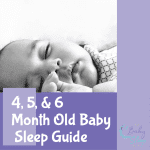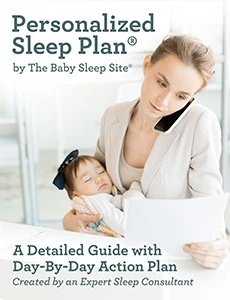
Your 2 or 3-month-old baby’s sleep is a period of transition. Your baby is still eating frequently and sleeping in short cycles. However, during this stretch, you will likely notice that your baby is increasingly alert. This can mean that some of the peaceful sleep you may have enjoyed during the first 8 weeks disappears.
By contrast, some parents find that sleep tends to even out a bit around 3 months. Some parents even start getting that elusive longer stretch of sleep at night around this time. That is, until possibly the 3 month old sleep regression or the 4 month old one.
However, if you’re still dealing with lots of night waking or with short naps, don’t worry. These are very common problems at this stage.
2 or 3 Month Old Baby’s Sleep: An Overview
At 2 months old, you will no doubt notice that your baby is becoming more and more alert. While this newfound alertness is exciting, it can also mean that your baby’s naps suddenly become shorter and more erratic. That can make it much harder to get your baby to actually fall asleep.
By the time your baby is 3 months old, however, sleep may have started to regulate itself. You may also find that your baby is beginning to consolidate feedings. You may start seeing more feedings during the day, with fewer happening at night.
How much should a 2-Month old sleep?
Most 2-month olds need 10-12 hours of nighttime sleep and 4-6 hours of sleep during the day for a total of ~14 hours of sleep in a 24-hour period. There are times when 2 month olds sleep more than usual.
How much should a 3-Month old sleep?
Most 3-month olds need 11-12 hours of nighttime sleep and 3-4 hours of sleep during the day for a total of ~14 hours of sleep in a 24-hour period.
The main difference between a 2-month old and a 3-month old is that a 3-month old may have transitioned to a 3-4-nap sleep schedule and their sleep may be becoming a bit more predictable.
2-3 Month Old Baby’s Sleep: Growth Spurts
There’s a growth spurt right around 2 months, and then another at 3 months. While some families may not notice these growth spurts at all, others will notice the telltale signs of a growth spurt at these ages – that is, a baby who seems extra hungry and extra sleepy.
This article about how baby growth spurts affect sleep is a helpful resource to get you through all your baby’s growth spurts.
2 Month Old Baby’s Sleep: Naps and Bedtime Help
Your 2-month-old baby’s naps may be erratic and short. That’s thanks to your baby’s new alertness and awareness of the world. You may also find that it’s harder to get your baby to fall asleep, now that she’s interested in and aware of what’s happening around her.
Don’t let this get you down – stick to your usual sleep and feeding cycles and routines. You’ll also want to watch for signs of over-tiredness carefully, as your baby may be too focused and alert to get drowsy and fall asleep when she’s really tired.
If you haven’t yet created a bedtime or nap time routine, this is a great time to start. There’s no better way to signal to your baby that it’s time to get drowsy and fall asleep! For more 2 month old baby sleep help, check out this article.
3 Month Old Baby’s Sleep: How Does It Change?
Your 3-month-old baby, on the other hand, may start to fall into a semi-predictable nap and feeding schedule. Not all 3-month-old babies do this, of course, but some babies show signs of regulating their sleep a bit at this stage.
By 3 months old, many parents start to notice slightly longer stretches of awake time during the day, and longer stretches of sleep at night.
However, don’t assume that this means sleep problems are solved. The 4 month sleep regression tends to throw even the best 3-month-old sleepers off their game!
That’s why it’s key to continue strengthening your nap time and bedtime routines at this stage. This is also a great time to begin working towards independent sleep if you haven’t already. Try putting your baby down drowsy but awake for one or two naps during the day.
How Many Naps Should a 2 or 3 Month Old Take?
This baby and toddler nap chart is a great resource for helping you determine the number of naps (and the ideal nap lengths) for your baby.
What Bedtime for a 2-3-Month-Old?
As for bedtime, many parents find a later bedtime works for their 2-month-old babies. That’s because, at this age, it still makes sense to time baby’s bedtime up with your own, in order to maximize your own sleep. Since a baby’s longest, deepest stretch of sleep is usually the first stretch after bedtime, this helps your sleep as well.
However, you can start easing into an earlier bedtime once your baby is 3 months old. This bedtime chart will help you identify your baby’s ideal bedtime.
Daily Schedules for a 2-Month-Old? Is That Possible? What About a 3-Month-Old?
Your 2-month-old baby’s schedule should allow for a relatively short wake time between naps. It should also allow for plenty of daytime feedings. Feeding often during the day is an important step to encouraging your baby to sleep through the night.
It’s also important not to focus much at all on the clock at this age. Instead, focus more on sleep and feeding cycles. While a small percentage of 3-month-old babies may fall naturally into a clock-based schedule, that is still a ways away for many babies.
Sample Schedules
Review these sample schedules for your 2-3-month-old but remember, they won’t always be overly predictable at this age:
To get a customized nap schedule template for your baby – one that accounts for your child’s age and usual morning wake-up time – use our custom baby and toddler schedule maker. Or, join/login to our VIP Members’ Area and use our members-only schedule maker. It includes feeding times!
Your 2 Month Old or 3 Month Old Baby: What You Need To Know About Sleep Training
Generally speaking, 2 months or 3 months old is too early to start working on formal sleep training in earnest. You’ll want to wait until your baby is around 4 months old before you start that.
However, this is a great time to start strengthening your pre-sleep routines. It’s also a good time to begin laying a foundation for healthy sleep habits if you haven’t already.
One way to do that is to establish fixed points in your baby’s day. You can start with your baby’s morning wake-up time. Then move to fixing the timing of the first nap, and/or bedtime. Fixed points are a great way to begin establishing a predictable sleep schedule, which is key to having a baby who eventually sleeps through the night. You might also want to look into using an Eat-Play-Sleep schedule!

If you are looking for ways to get your 2 month old or 3 month old baby sleeping better, our VIP Members Area is an awesome resource! It’s the sleep help resource that really grows with your child. When you join The Baby Sleep Site®’s VIP Members Area, you’ll have access to sleep tools designed for newborns through toddlers – and everything in between! Our VIP Members Area is packed with exclusive content and resources. This includes e-books, assessments, detailed case studies, expert advice, peer support, and more. It actually costs less to join than to buy products separately! As a VIP member, you’ll also enjoy our “Ask the Author” feature getting answers to your pressing questions from a sleep consultant!
For more help with your 2 month or 3 month old, Check out these specific VIP Members Area-only resources:
- Meet Caitlin Who Successfully Sleep Trained Her 3 Month Old
- Essential Keys To Your Newborn’s Sleep (digital e-Book)
- Mastering Naps and Schedules (digital e-Book)
- “Ask the Author” with a Sleep Consultant
- Establishing Healthy Sleep Habits in Your Newborn (audio course with Nicole)
- How To Put Your Baby On A Schedule (audio course with Nicole)








